
oil-paint
#
allegory
#
baroque
#
oil-paint
#
figuration
#
oil painting
#
mythology
#
history-painting
Copyright: Public domain
Editor: So here we have *Le Triomphe de Junon* – The Triumph of Juno – an oil painting by François Lemoyne. I get a very light, airy feeling from it, almost like you could float right into the scene. And of course Juno herself looks supremely regal! What stands out to you when you look at this work? Curator: You know, it makes me think of those fluffy powdered wigs they used to wear at court! All this frothy pink and baby-blue, it's pure visual candy. What's so compelling is how Lemoyne uses all these symbols--the peacock, for instance, practically screams Juno! Have you considered the perspective and its almost dizzying effect, pulling your eye straight into the heavens? Editor: I hadn't thought about the colours in relation to fashion, but that's spot on! I can also see the peacock symbolising Juno's vanity! Do you think that that was the only reason it's used? Curator: Hmm, not quite! While vanity can certainly play a part, the peacock was primarily seen as Juno’s attribute, often representing watchfulness, pride, and beauty befitting a queen of the gods. Now, notice the *putti*, the little cherubs... What sort of impact do *they* have? They feel playful and mischievous, right? Editor: Yes, they bring an element of lightness and joy that contrasts with Juno’s formal pose! All this focus on colour and form makes me wonder if it really served any deeper purpose. It seems so flamboyant and unsubtle. Curator: I can see your point! This was meant to dazzle – a feast for the eyes as well as the mind! And maybe the 'deeper purpose' is simply to uplift and inspire awe. Isn't that valid too? Editor: Absolutely! It’s interesting how the surface appeal is intertwined with its historical and mythological layers. I didn't appreciate this originally, and that has changed my view a great deal! Curator: Mine too, in a way.
Comments
No comments
Be the first to comment and join the conversation on the ultimate creative platform.













